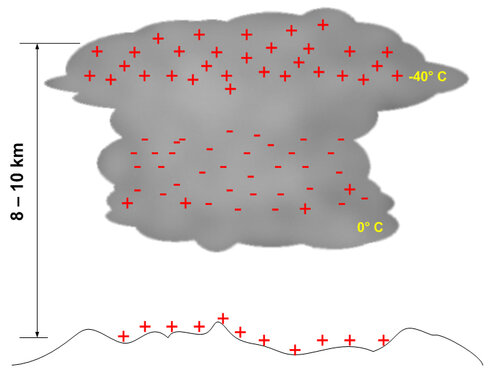Lightning Physics

Lightning Discharge
The lightning discharge has its origin in the electrically charged thundercloud. The exact mechanisms of the large scale charge separation within the thundercloud and the initiation of the discharge itself are still not fully understood and subject of ongoing research.
We have to distinguish between the microscopic charge separation of the cloud particles (water, ice) and the macroscopic charge separation within the thundercloud. It is assumed that there are two main charge centers in a thundercloud, with positive charges on ice crystals located in the upper regions and water droplets with negative charges in the lower regions of the cloud. In a first approximation the thunderstorm cloud has a charge distribution corresponding to a dipole. Usually a small layer of positive charge is observed at the cloud base region.
The classification of lightning discharges is based on the observed polarity of the charge "effectively" lowered to ground and the direction of propagation of the initial leader. Four different types of lightning discharges between cloud and earth have been identified. The four types of lightning are (1) downward negative lightning (2) upward negative lightning (3) downward positive lightning, and (4) upward positive lightning.
This form of classification was introduced by Prof. BERGER, one of the pioneers of lightning research. The form of discharge most frequently examined is the negative cloud-to-ground lightning (downward negative lightning), as more than 90 % of all flashes meet this type of discharge. Therefore it is of fundamental importance for the design of lightning protection systems.
Each lightning stroke is composed of a downward-moving process, termed "leader", and an upward-moving process, termed "return stroke". The leader creates a conducting path between the cloud charge source region and ground and distributes electric charge from the cloud source along this path. The return stroke traverses that path moving from ground toward the cloud charge source and neutralizes the leader charge.
The first-stroke leader in negative flashes often appears heavily branched and optically to be an intermittent process and is called "stepped leader". The tip of a subsequent-stroke leader in negative flashes appears to move continuously and is called "dart leader". The apparent difference between the two types of leaders is related to the fact that the stepped leader develops in virgin air, while the dart leader follows the "pre-conditioned" path of the preceding stroke or strokes. Sometimes a continuously moving dart leader becomes stepped, in which case it is called "dart-stepped leader".

Three phases of a cloud-to-ground lightning
When the downward leader approaches ground level a connecting leader, often initiated from the top of objects, is observed. When descending leader and upward connecting leader meet, the main discharge, the return stroke, starts. At the initiation point of the connecting leader the well-known pulse-shaped lightning current occurs with an amplitude of several 1,000 Amperes up to some 100,000 Amperes. The rise time of the current is in the microsecond range. The negative charge deposited along the leader channel is discharged to the ground. The figure schematically shows the three main phases of a lightning discharge.
The high-current return-stroke wave rapidly heats the lightning channel to a peak temperature of about 30,000° K and creates a high channel pressure. High temperature and pressure result in channel expansion, intense optical radiation, and an outward propagating shock wave that eventually becomes the thunder (sound wave).
Subsequent Strokes
Most lightning flashes are composed of multiple strokes. All strokes other than the "first" are referred to as "subsequent" strokes. A subsequent stroke is initiated by a downward leader (mostly dart leader) following the channel of a previous discharge after a typical inter-stroke interval of 35 ms. The dart leader charge is deposited again along the lightning channel and when the dart leader reaches the ground a subsequent return stroke occurs. This dart leader/return stroke sequence can be repeated several times within about one second total duration of a lightning flash. A lightning flash with up to 20 and more strokes can exceed a total duration of more than one second. Flashes with a large number of subsequent strokes typically show a significant "flickering" of the lightning channel also seen with the naked eye.
A typical flash has three to four subsequent strokes. In Austria, about 50 % of the ALDIS detected flashes are multi-stroke flashes. This shows that multi-stroke discharges are common and not exceptional.
The impulsive component of the current in a return stroke is often followed by a "continuing current" which has a magnitude of tens to hundreds of amperes and a duration up to hundreds of milliseconds. Continuing currents usually occur in subsequent strokes. Between 30 % and 50 % of all negative cloud-to-ground flashes contain long continuing currents. The high amount of transferred charge during the continuing current phase is assumed to be the main cause of forest fire initiation and perforation of metal sheets due to lightning.
A possible dependence of lightning parameters on geographical location has been pointed out for many years, in particular the peak current of first strokes, however, no conclusive evidence has been reported in literature until now.